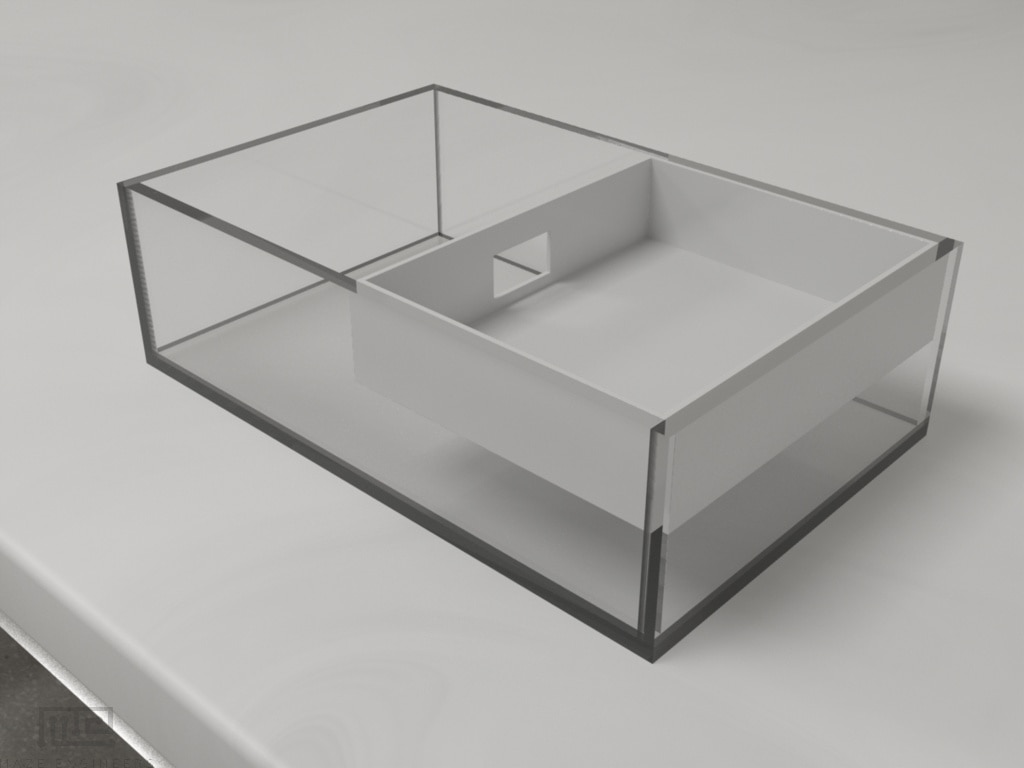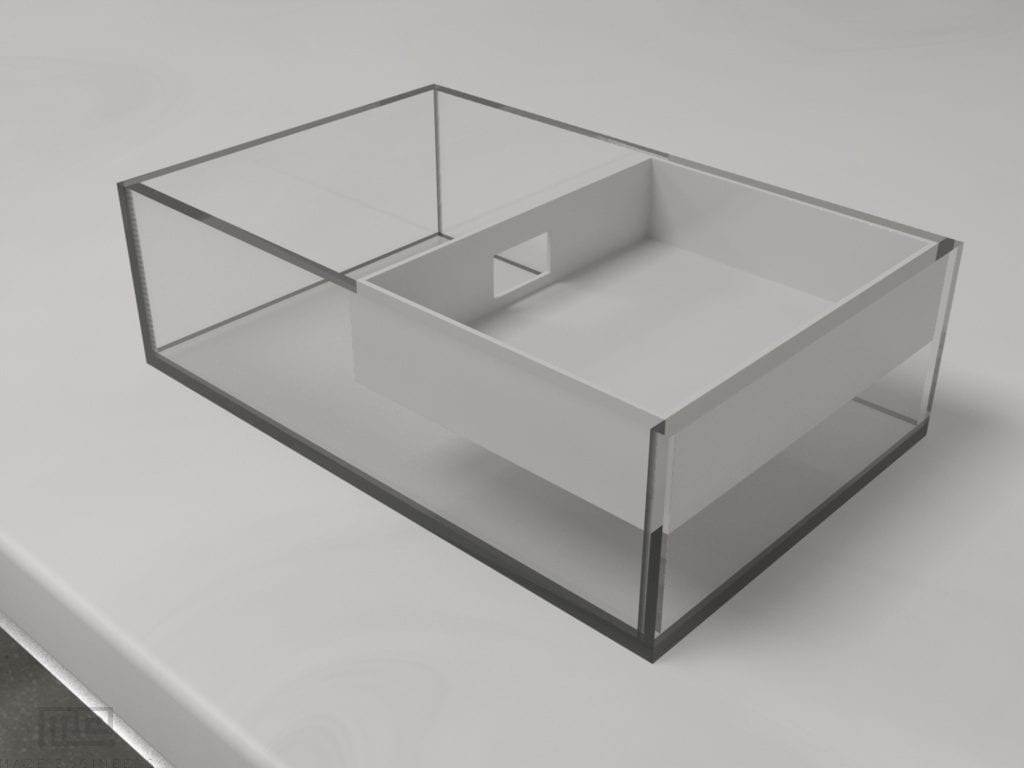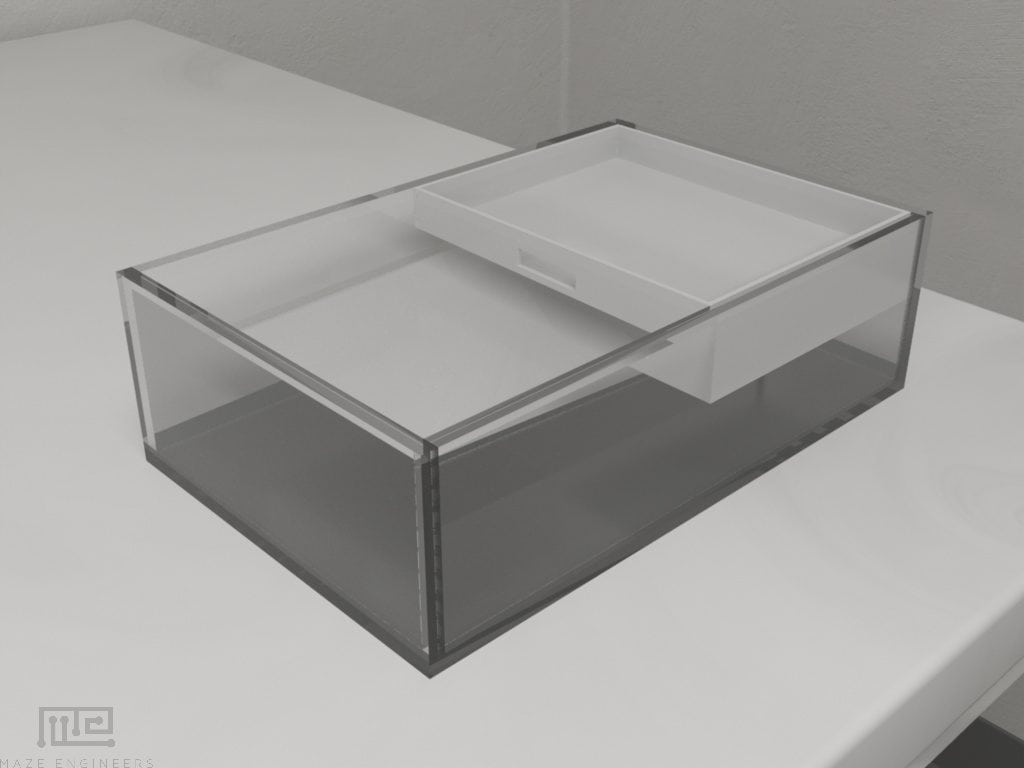Description
- The MazeEngineers Bite test comes with a plastic apparatus that can be placed inside of the home tank, or a built in apparatus that is continuous with the home cage. The Bite test apparatus (15×12×3.5 cm) is placed inside the home tank, so that it was filled with water to a depth of 3 cm.
- It is connected to the main part of the tank by a small opening (3 cm wide) through which the fish can enter the box
- The bite apparatus can be removed for easy cleaning
Miklosi A, Andrew RJ. Right eye use associated with decision to bite in zebrafish. Behavioral Brain Research. 1999;105:199–205.
Price & Dimensions
Bite Test Chamber
$ 690
Per Month- Length: 15cm
- Width: 12cm
- Height: 3.5 cm
- Opening: 3cm
Bite Test Chamber with Home Chamber
$ 1690
Per Month- Length: 15cm
- Width: 12cm
- Height: 3.5 cm
- Opening: 3cm
- Chamber: 30cm x 30cm x10cm height
Documentation
Introduction
Zebrafish bite test evaluates cerebral lateralization which promotes the use of a particular eye, according to the visual stimulus that is being fixated. Additionally, the Bite test apparatus is employed to assess and correlate the biting habituation in Zebrafish to the preferential eye use, on viewing a novel object.
Bite test apparatus can also be employed to study the change in Zebrafish’s biting behavior by using the beads of different colors. This observation assists in evaluating the colors that stir the biting interest in this species. This makes the Bite test apparatus highly practical in observing a broad paradigm of behaviors in Zebrafish that proves the presence of cerebral lateralization.
The apparatus can be conveniently attached to the inside of a home tank. The Bite test apparatus stays connected to the main part of the tank with the help of a small opening that allows the fishes to enter or leave the box during the trials expediently.
The findings from the past research suggest that the right eye is mostly used by the Zebrafish when a stimulus requires a close examination in order to decide on a response. Right eye use is associated with the decision to bite in Zebrafish (Miklosi and Andrew RJ, 1999). On the other hand, Bisazza et al., 1997 observed that the left eye is used to check if the stimulus has been seen before in poecilid fish.
The bite test is prudentially designed to prove the same association of the preferential eye use with biting. This test is conducted in four trials in which the subjects are exposed to beads (either colored or black and white). The biting habituation and the right eye use are observed separately in each trial. Since the bite test apparatus allows the subjects to enter and leave the box at their free will, this apparatus is also ideal to observe the mnestic tendency along with the other traits.
Apparatus and Equipment
There are two versions of the bite test apparatus; both of which are equally effective in observing the cerebral lateralization and biting habituation in Zebrafish.
One type of this apparatus is available as a bite test chamber, which is a plastic box that can be conveniently placed inside the home tank. This version of the bite test apparatus is 15 cm long, 3.5 cm high and 12 cm wide. The apparatus contains a 3 cm wide opening that connects the apparatus to the inside of the home tank. This opening is broad enough to allow the Zebrafish to enter or leave the apparatus.
The other version of the bite test apparatus comes as a home cage with a built-in bite test chamber. It doesn’t require fitting this apparatus in any other tank, as this apparatus is large enough to host both the subjects and the bite test chamber. The home chamber, in this type of bite test apparatus, is 30 cm long, 10 cm high and 30 cm wide.
The convenient dimensions of the apparatus allow the subjects to freely move their bodies according to the view that is being observed. This free movement of the Zebrafish within the apparatus is helpful in analyzing the hemisphere that is used in making decisions against a particular response or stimuli. The bite test chamber, in both the versions, can be easily detached for disinfection and cleaning.
Training Protocol
Pre-Training for Zebrafish Bite Test
Five days prior to the start of the experiment, adult female Zebrafishes are placed inside a holding tank. The bite test apparatus is fitted inside the tank and is filled with the water to a depth of 3 cm. The subjects are exposed to a 14-hour light and 10-hour dark cycle. In order to accustom the subjects to visit the box regularly, the food is sprinkled over the water surface of the bite test chamber. On the day of trial, the fishes are fed only one, and that too after the test is completed.
At the start of the experiment, round beads (around 2.5 mm in diameter) are mounted on a transparent vertical rod (around 2 mm in diameter). This arrangement is fixated at the far end of the box, which is opposite to the opening. The bead is dipped 1 cm below the water surface so that it is at the eye level of the fish.
In a four trial bite test, both the biting and the right eye use are always much higher during the first trial. It is also noticed that the use of colored beads incites more interest in Zebrafish as compared to the black and white beads.
Two major factors are employed for the bite test analysis. Firstly, the time spent by fish inside the apparatus during the trial is measured. This helps in analyzing the body position of the subject while it observes the stimulus; as to whether the right or left eye is being used. Secondly, the numbers of bites on the bead are counted which signifies the biting behavior during the different trials.
Evaluation of Cerebral Lateralization
The bite test apparatus is highly effective in evaluating the cerebral lateralization in Zebrafish. The position of the body relative to the stimulus signifies the viewing angle of the fish. This aids in establishing the eye that is being fixated towards the stimulus.
Evaluation of Biting Behavior
Bite test apparatus can be used to determine the biting behavior by exposing the beads of different colors. This chromatic display excites various responses in Zebrafish, which leads to the evolution of the eating and biting habits in this species.
Evaluation of the relation between the Right Eye Use and Decision Making
This apparatus is helpful in determining the correlation of the right eye use with the decision making. The sharp drop in the right eye use in the second and third trials of the bite test strongly suggests that the right eye is used to decide the reaction towards a novel stimulus.
Strengths & Limitations
The bite test chamber offers an unparalleled advantage in observing the correlation of decision making and the right eye use in Zebrafish. In the absence of a neck, the angle of the body can be easily seen through the apparatus which helps in tracking the eye that is being used by the subject to evaluate the stimulus. Additionally, the combined use of the bite test chamber and host tank provides a favorable environment to the fish allowing the subjects to display their natural behavioral traits.
The convenient dimensions of the bite test apparatus facilitate the fishes to move their bodies freely according to their view of interest. These free movements within the apparatus assist in observing the hemisphere that is used in making decisions against the exposed stimulus.
Furthermore, the bite test apparatus is ideal to gauge the mnestic tendency of this species towards the stimuli of different colors.
Summary and Key Points
- Bite tests are widely conducted to study cerebral lateralization.
- Bite test apparatus is made up of plastic that can easily fit inside a home tank; while it simultaneously stays connected to the main part of the tank through a 3 cm wide opening.
- Another version of this apparatus comes with a host tank accompanied with the bite test chamber, hence eliminating the need to use the home tank.
- It can be employed in the evaluation of biting behavior and its correlation with the preferential eye use and decision making.
References
Mench JA, Andrew RJ. (1986). Lateralisation of a food search task in the domestic chick : Behavioral and Neural Biology.
Bisazza A, Pignatti R, Vallortigara G. (1997) Laterality in detour behaviour: interspecific variation in poeciliid fish : Animal Behavior
Miklosi A, Andrew RJ. (1999) Right eye use associated with decision to bite in Zebrafish : Behavioral Brain Research




